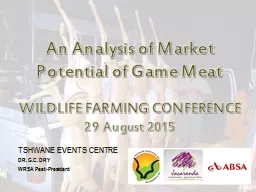

WILDLIFE FARMING CONFERENCE 29 August 2015 TSHWANE EVENTS CENTRE DR GC DRY WRSA PastPresident Bergh AN ANALYSIS OF THE MARKET POTENTIAL FOR GAME MEAT WRSA PastPresident Dr GC Dry Scope of the Wildlife Ranching Industry ID: 528561
Download Presentation The PPT/PDF document "An Analysis of Market Potential of Game ..." is the property of its rightful owner. Permission is granted to download and print the materials on this web site for personal, non-commercial use only, and to display it on your personal computer provided you do not modify the materials and that you retain all copyright notices contained in the materials. By downloading content from our website, you accept the terms of this agreement.
Slide1
An Analysis of Market Potential of Game Meat
WILDLIFE FARMING CONFERENCE29 August 2015
TSHWANE EVENTS CENTREDR. G.C. DRYWRSA Past-President
© BerghSlide2
AN ANALYSIS OF THE MARKET POTENTIAL FOR GAME MEAT
WRSA Past-President: Dr GC DryScope of the Wildlife Ranching IndustryIdeology & Culture underpinning Wildlife RanchingSuccesses of Game Ranching in South AfricaConservation Failures WorldwideWildlife Ranching Countering Worldwide TrendsProfile of Investors & OwnersCurrent Supply of Game Meat2025 Forecast
ABSA Agri: Ernst
Janovski
© van der MerweSlide3
Scope of the Wildlife Ranching Industry
Private Game Ranchers: 16.8% of agricultural landState owned Protected Areas: 6.1% of agricultural footprintR20 billion annual contribution to GDP20 million + heads of game in private ownership6-8 million heads of game in Protected Areas14-15 million head of cattle (9 million in commercial sector)Investment:20 million ha land utilized for game ranching @ R10 000/ha = R200 billionGame, infrastructure & equipment = R200 billionSlide4
Ideology & Culture Underpinning Wildlife Ranching
OwnershipConstitution, Common Law & Game Theft Act (1991)Green Economic Principles & Sustainable UseLove of NatureCompassion for AnimalsSlide5
Successes of Game Ranching in South Africa
20 million ha of marginal, often damaged agricultural land converted to sustainable land-use option.Note: the 20 million ha is ex-agricultural land, not degraded conservation land.140 000 sustainable jobs:3x compared to domestic stock operationsSalaries 3x domestic stock equivalentsIncreased biodiversity, e.g.Oxpeckers – previously threatenedDung beetle species increaseVulture “restaurants”Other raptors
© van der MerweSlide6
Successes of Game Ranching in South Africa
Wildlife ranching plays a major role in:Saving species (white rhino; bontebok; Cape mountain zebra; black wildebeest; geometric tortoise and a number of other species, as well as,Protecting the rich diversity of vegetation typesContributing to increasing landscape connectivity (Cousins, J)Green Economy SuccessSlide7
Food Security:
“Food security” implies physical, social and economic access by all South Africans, at all times, to sufficient, safe and nutritious food which meets dietary needs for an active and healthy life. The following dimensions are relevant:adequate availability;access to;
affordability; stability; use of marginal agricultural land to produce commodities, e.g. game to generate local and foreign revenue that can be used for the importation of essential food commodities.
Successes of Game Ranching in South Africa (continued)Slide8
Conservation Failure Worldwide
The primary causes of species and habitat loss (in Southern Africa) are conversion to cultivated land, followed by urban sprawl, alien plant invasion and plantation forestry.74 largest terrestrial herbivore species on Earth (body mass >100 kg), are generally facing dramatic population declines and range contraction, such that ~ 60% are threatened with extinction.Kenya: lost almost 80% of its wild animals since the ban on hunting and trade.Slide9
Wildlife Ranching Countering Worldwide Trends
Source: Drs Pamela and Peter Oberem Embargo on use or publication.Slide10
Profile of Investors & Owners
In business & management language the combination of investors, owners, product and capacity, reflects a sound indicator of sustainability.© BerghSlide11
Profile of Investors & Owners
Investors:Trade NameInvestors well-educated/informed (50% undergraduate or post-graduate degree, 26% diploma, 14% matric)
Shareholder agreements increased
From 2009-2013 with 37%
From 2013 with 18%Slide12
Profile of Investors & Owners
OWNERSAgricultural Land Classification SchemeSimilar to shareholders, well-educated with 76% tertiary education and 20% matricMethod of acquiring game farmMost popular species ranched are kudu (77%), common impala (76%), blesbok (62%), waterbuck (60%), blue wildebeest (59%), eland (59%).
Bought a cattle or crop farm and converted in into game farm46%Bought already existing game farm23%Bought a cattle or crop farm that was already partially converted to a game farm
9%Inherited cattle or crop farm and converted it into game farm
6%
Inherited cattle or crop farm that was partially converted into a game farm
8%
Other
8%Slide13
Current Local Supply of
Game Meat30 000 tons of game meat (undeclared) estimated used in processed meats such as polonies, sausage, etc.120 000 tons of game meat hunted by local hunters annually.20 000 tons of game meat hunted by trophy hunters annually.1 400 tons harvested annually for
meat directly150 000 tons (estimated) utilized annually in South Africa
Note: Beef imports for 2015 expected to be > 65 000 tons.
*
(Johan Kruger Game Harvesters Association, 2015)© BerghSlide14
Current Export Supply of
Game MeatPRIOR TO FMD OUTBREAK FEBRUARY 2011Exported between 600-800 tons of boneless product to EuropeSought after species not sufficiently available e.g. springbok, kudu and blesbokWRSA GOAL FOR 2015To reach 10-12 000 tons (providing R1.5 billion + foreign revenue per annum)MAIN CONSTRAINTS
Fragmented nature of supply chainVeterinary Services meeting OIR requirements for FMD controlApproved abattoirs (game meat scheme / DAFF regulations and approved mobile abattoirs)
© Bergh
© BerghSlide15
2025 FORECAST
Land use option under Game Ranching: 30 million ha (30% SA’s Agri land)30 million head of game.350 000 decent sustainable employment opportunities.250 000of game meat produced per annum.R75 billion per annum contribution to GDPWRSA seconds Walt Disney’s notion namely;
If you can dream it, you can do it!© BerghSlide16
THANK YOU© van der Merwe